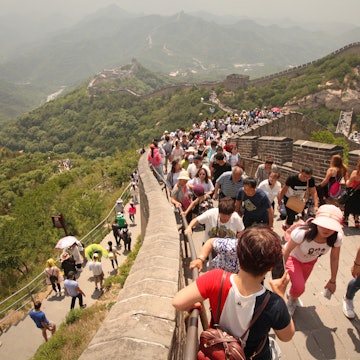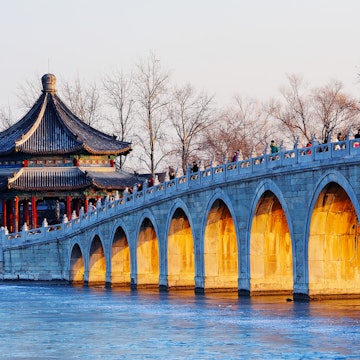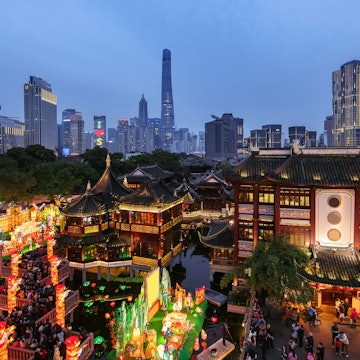
The Lonely Planet guide to Beijing’s Tiananmen Square

Aug 6, 2025 • 10 min read
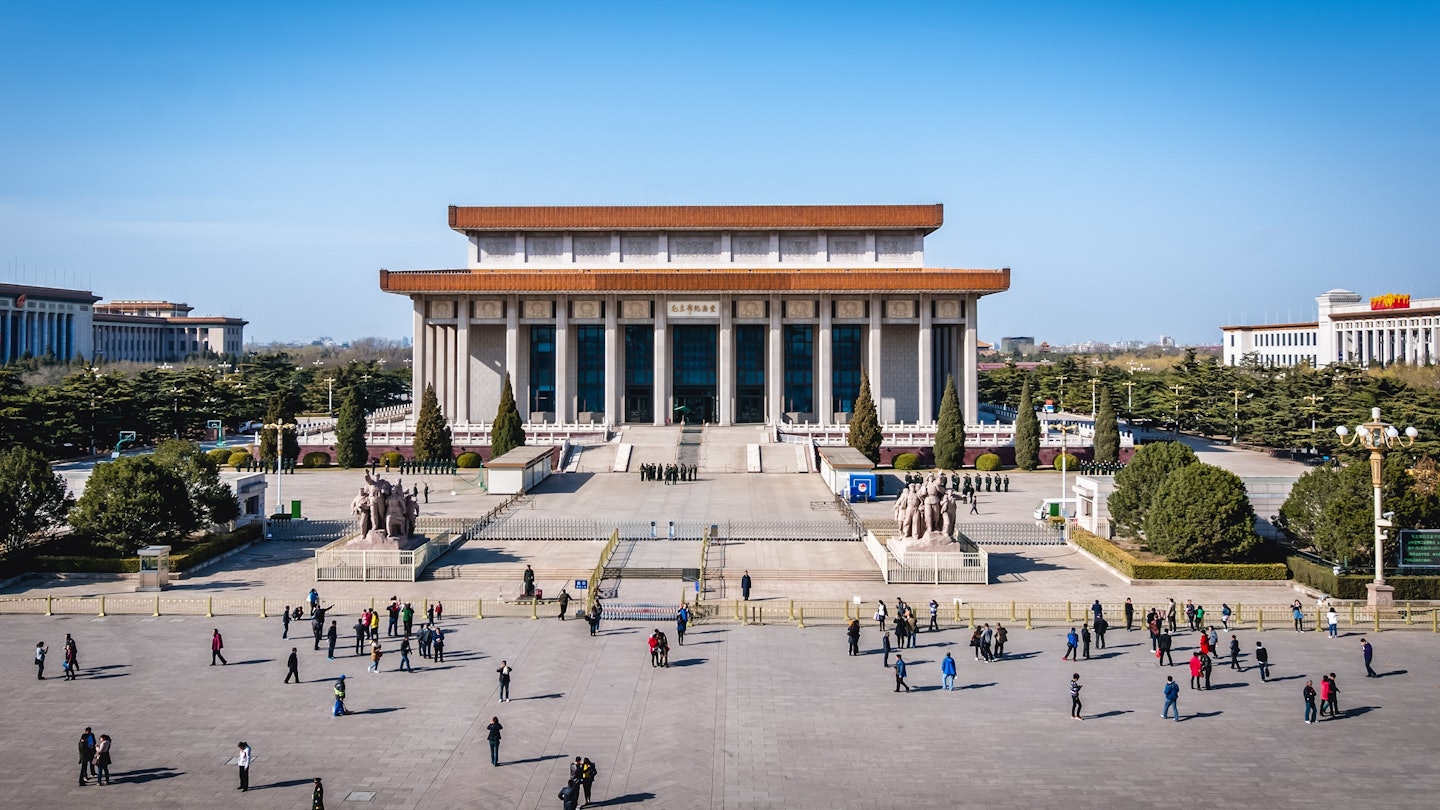
Tiananmen Square marks the center point of modern Beijing. Fotokon/Shutterstock
Nowhere conjures up the dense history and complex politics of China quite like Tiananmen Square. Flanked by triumphalist Soviet-style buildings, and bookended by ancient gateways that once served as exclusive entrances to the Imperial City, this imposing square at the heart of Beijing is hallowed ground for the Chinese Communist Party, and for China’s very sense of nationhood.
Watched over by an iconic portrait of Mao Zedong displayed on the Gate of Heavenly Peace – and haunted by the ghost of past protests – it’s not the most easygoing of places to visit, thanks to vigorous security checks for all visitors. Yet it remains one of the nation's most stirring destinations.
Combined with a visit to the adjacent Forbidden City, Tiananmen should be the anchor stone of any visit to Beijing. Here’s everything you need to know about visiting the spot where the People's Republic of China was founded.
What’s the history of Tiananmen Square?
Tiananmen Square takes its name from the Gate of Heavenly Peace at its northern end, which was constructed in 1417 as the southern entrance to the imperial palace – known today as the Forbidden City. The square in front was laid out in the 1650s, and later occupied by a string of invading armies, including British soldiers during the Second Opium War in 1860 and Chinese rebel forces during the Boxer Rebellion of 1900.
Tiananmen was enlarged massively in the 1950s, after Mao Zedong proclaimed the founding of the People's Republic of China here on October 1, 1949. Monuments to Mao’s vision of a new China were erected around its periphery, and the square quadrupled in size. After Mao’s death in 1976, his embalmed body was placed on public display inside the Chairman Mao Memorial Hall in the center of the square.
Tiananmen Square is best known outside China for the tragic events of June 3–4, 1989, when a government crackdown on pro-democracy protests led to many deaths, but this is rarely acknowledged inside the country. Younger Chinese people know little about the protests, and discussing these events within China could have repercussions.

When should I go to Tiananmen Square?
You need a reservation to enter Tiananmen Square, and this grants you entry during a specific time slot. Each time of day has its own appeal: you can come early in the morning for the flag-raising ceremony, enter during the morning or afternoon for peak sunshine, or come in the evening for the flag-lowering ceremony and to see the illumination of the monuments around the square.
The most enjoyable time to visit is during the spring (from April to May) or the fall (from September to October) when temperatures are mild. Exploring can be draining during the hot, humid summer, and a shiver-inducing experience during the icy winter.
How much time should I spend at Tiananmen Square?
You can take in the atmosphere of the main square on a quick walk around, but if you want to visit the other sights here, such as the National Museum of China and the Chairman Mao Memorial Hall, there’ll be lots of queuing for security checks, so give yourself plenty of time. You also need to pass through a time-consuming security screening just to enter the square.
Plan on half a day exploring the sights around Tiananmen Square, and another half day of sightseeing if you continue into the Forbidden City. While you can enter the Forbidden City from Tiananmen Square, you cannot then head back into the square – so plan on visiting Tiananmen in the morning and the Forbidden City in the afternoon.
What’s the best way to see Tiananmen Square?
To enter Beijing’s most important public space, you'll need to reserve a free ticket, queue for entry and pass through a security check; you’ll likely need to show your passport multiple times. Come in the morning if you hope to have time to visit Tiananmen Square and the Forbidden City in one day.
At the time of writing, Tiananmen had two main entrances – one at the Tiananmen East subway stop (Line 1) and the other at the Qianmen subway stop (Line 2). Once you pass through the security check and gain access to the square, you'll be able to visit several other sights, including the Chairman Mao Memorial Hall in the center of the square, the National Museum of China on the east side of the square, and the Gate of Heavenly Peace to the north.
To get the best from a morning at Tiananmen, come early for the flag-raising ceremony and take a walk around the square, admiring the landmark architecture on all sides. Snap some photos in front of the portrait of Mao on the Gate of Heavenly Peace, then move on to the museum and monuments.
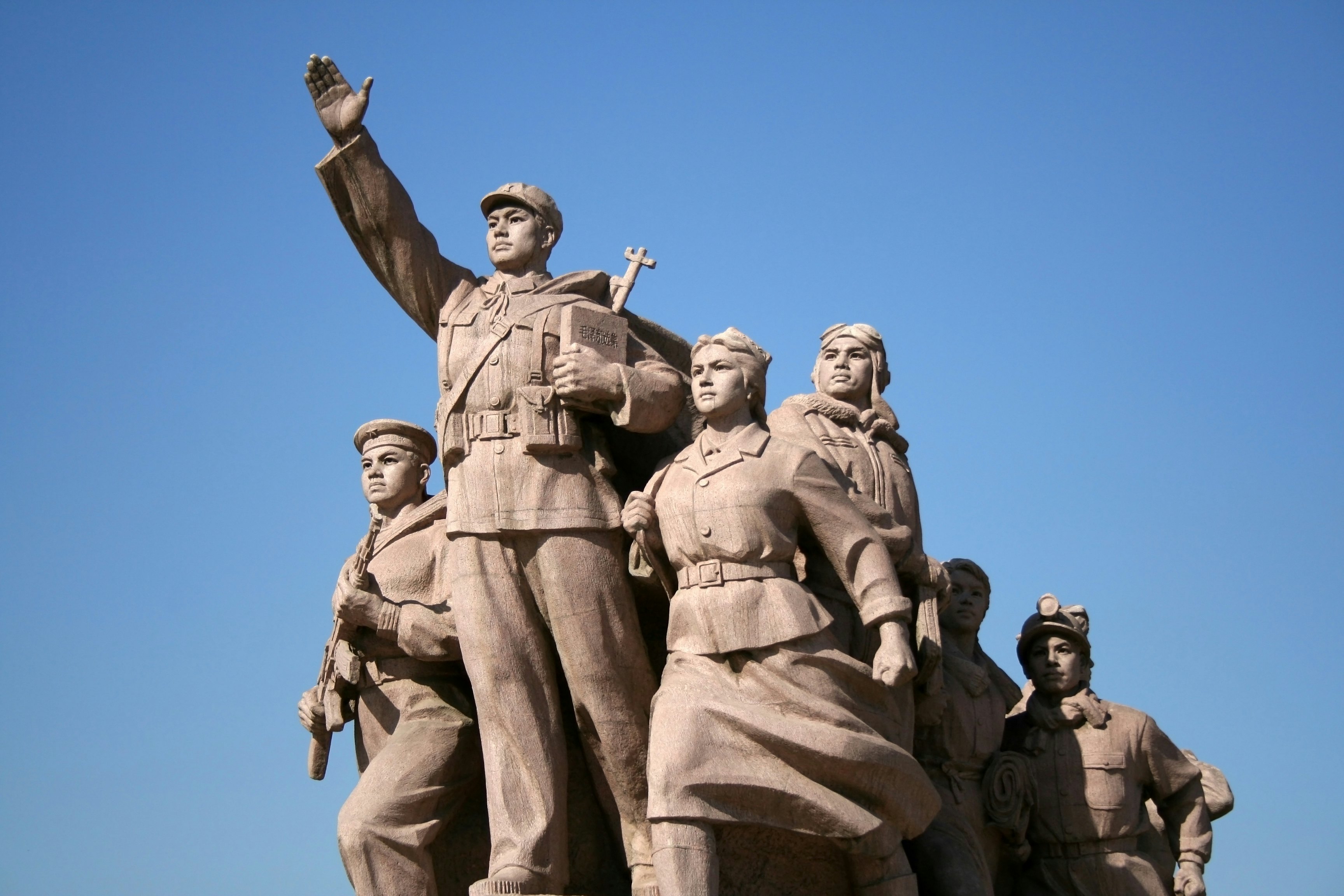
How much do tickets to Tiananmen Square cost?
Tickets to enter Tiananmen Square are free, but they must be reserved ahead online via a mini-program on the WeChat app, which is only available in Chinese. You may need some assistance from your hotel or from someone else who can read Chinese script to make a booking.
Separate tickets are required for the constituent sights around the square, such as the National Museum of China and Mao’s mausoleum, and these must also be booked via WeChat. Admission is linked to your passport, so you’ll need to display this rather than a physical or digital ticket to enter the square and the various monuments and museums.
What should I eat and drink at Tiananmen Square?
A few simple cafeterias are located in the square’s southeastern corner, near the Qianmen entrance. If you have tickets for the National Museum, its cafe is better. Otherwise, bring snacks and save lunch until after you’ve finished exploring. The food court in the basement of the Oriental Plaza mall is a handy place to fill up on noodles, hotpots and capital-region cuisine. It’s just one stop from Tiananmen Square on the subway, by the Wangfujing station.

What are Tiananmen Square’s must-sees?
Many visitors treat Tiananmen Square as a warm-up act for the Forbidden City, but the square worth exploring in its own right, both for its sense of history and for the important civic buildings and national monuments and museums that surround it.
Tiananmen Square itself
The rectangular arrangement of Tiananmen Square, with its lines of red flags rippling in the wind, pays homage to traditional Chinese architectural concepts, though most of its buildings and their ornamentation are Soviet-inspired. Mao conceived the square as a projection of the power of the Communist Party; during the Cultural Revolution, he viewed parades of up to a million people here.
However, Tiananmen has a much longer history as a civic space. The Gate of Heavenly Peace at the northern end was traditionally where commoners and officials could lodge grievances with the emperor – a practice that was revived several times during the 20th century, including on May 4 1919, and in 1989, following the death of the reform-minded general secretary Hu Yaobang.
Dotted around the square are patriotic monuments such as the Monument to the People’s Heroes, a towering obelisk raised in 1959, and the four memorial statues flanking the Chairman Mao Memorial Hall, showing the people being lifted by the glorious revolution.
Early risers can watch the daily flag-raising ceremony in the square at sunrise, performed by a troop of People’s Liberation Army (PLA) soldiers marching at precisely 108 paces per minute, covering precisely 75cm (29.5 inches) with each step. A flag-lowering ceremony (the same thing in reverse) is performed at sunset.

National Museum of China
Beijing’s best museum, the National Museum of China is ensconced within the massive Tiananmen security zone, meaning you’ll need to pass through security queues twice (once for the square and again for the museum) just to get in. Again, you’ll need a free WeChat reservation to enter. The museum is closed on Mondays.
Despite these hurdles, the museum is absolutely worth it. The basement is the star attraction, where numerous galleries introduce artifacts that span the entirety of Chinese civilization, including impressive collections of bronze art and Buddhist sculptures.
Treasure hunters should seek out the 2000-year-old jade burial suit, made for King Liu Xiu of the Western Han dynasty, and the life-sized bronze acupuncture statue dating from the 15th century. A 2000-year-old rhino-shaped bronze zūn (wine vessel) is another stand-out treasure.

Chairman Mao Memorial Hall
One of Beijing’s more surreal spectacles is the sight of Mao Zedong’s embalmed corpse on public display within his mausoleum, located at the heart of Tiananmen Square. Mao's body lies in a crystal cabinet, draped in a red flag emblazoned with a hammer and sickle, as guards in white gloves impatiently wave visitors on toward further rooms where a riot of Mao kitsch – lighters, bracelets, statues, key rings, bottle openers, you name it – awaits.
To enter, you must make advance reservations via WeChat. The mausoleum is open from 8am to noon daily (except Monday), but tickets are extremely hard to get. For your best chances, try coming on a weekday and booking five or six days ahead. If you can’t get a spot, the stirring socialist-realist war memorials outside the mausoleum make for good photo ops.
Gate of Heavenly Peace
Looming large at the north end of Tiananmen Square, and instantly recognizable by its giant framed portrait of Mao, the double-tiered Gate of Heavenly Peace, from which the square takes its name, is a potent national symbol. It was formerly the largest of the four gates along the walls of the Forbidden City, and it was here that Mao proclaimed the founding of the People’s Republic of China in 1949.
Every year, millions of visitors quickly pass under the gate to enter the Forbidden City – but it’s also worth visiting the upper levels of the gatehouse for incredible views over the square. To enter, you’ll need a pre-booked WeChat ticket, and these get snapped up quickly.
The balcony is about as sacred a space as you can find in communist China, so be on your best behavior. If you don't have tickets to enter the upper levels, you can still walk beneath the gate, and imagine the pomp that once greeted the dignitaries passing through its arches and into the Forbidden City.

Great Hall of the People
Monolithic and intimidating, the Great Hall of the People on the west side of the square houses the highest organ of state power, the National People’s Congress (NPC). It was constructed in 1959 as one of Mao’s “10 Great Buildings” on a site previously occupied by Taichang Temple, the Ministry of Justice, and the Jinyiwei, Beijing’s Ming dynasty–era secret service.
While few travelers enter, it’s worth the diversion to admire the 10,000-seat auditorium with a red star embedded in a galaxy of ceiling lights. Reserve a free ticket via WeChat, as with the other monuments at Tiananmen.
Zhengyang Gate
At the south end of the square, the grand gatehouse known as the Zhengyang Gate (or Qianmen, meaning “front gate”) was constructed in 1419 to protect the southern entrance to the Inner City as part of the now-demolished city walls. The gate sustained damage during the Boxer Rebellion of 1900, but it was restored in 1914.
The capital’s original railway station stood just outside the gate, before services shifted to the new Beijing station in 1959. Just south, across Qianmen Xidajie, is the tall Jian Lou (Arrow Tower), a 15th-century defensive tower designed to give archers an elevated firing position.
Is Tiananmen Square accessible?
The open areas of Tiananmen Square are accessible for wheelchair users and those with restricted mobility, with ramps and step-free routes helping visitors pass through security. Some sights around the square are also reasonably accessible, such as the National Museum of China, though other buildings can only be accessed via steps.
This article was adapted from Lonely Planet’s China guidebook, published in August 2025.






